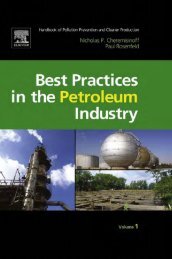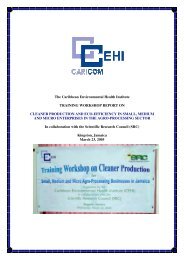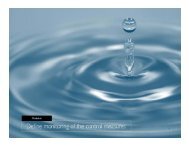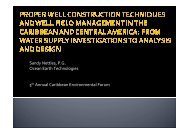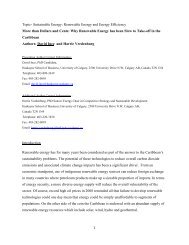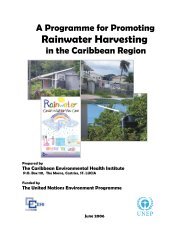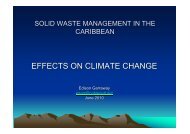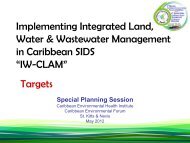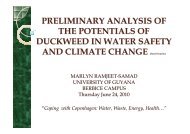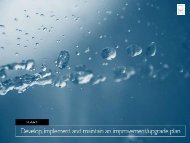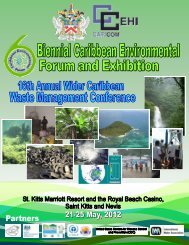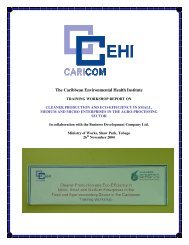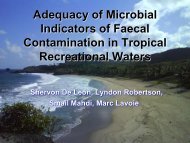Describe the water supply system
Describe the water supply system
Describe the water supply system
You also want an ePaper? Increase the reach of your titles
YUMPU automatically turns print PDFs into web optimized ePapers that Google loves.
Module 2 <strong>Describe</strong> <strong>the</strong> <strong>water</strong> <strong>supply</strong> <strong>system</strong><br />
Session structure<br />
• Overview<br />
• System components and description<br />
• Outputs<br />
• Challenges<br />
• Factors to consider<br />
• Exercise<br />
2
Module 2 <strong>Describe</strong> <strong>the</strong> <strong>water</strong> <strong>supply</strong> <strong>system</strong><br />
Overview<br />
• First task of WSP team<br />
• Aim: To enable risks to be assessed and managed<br />
• Involves field investigations and local knowledge<br />
• Each <strong>system</strong> assessed on its own<br />
• Involves documentation, review and update<br />
3
incident<br />
Module 2 <strong>Describe</strong> <strong>the</strong> <strong>water</strong> <strong>supply</strong> <strong>system</strong><br />
Revise WSP<br />
following incident<br />
(Module 11)<br />
Assemble team<br />
(Module 1)<br />
<strong>Describe</strong> <strong>the</strong> <strong>water</strong><br />
<strong>supply</strong> <strong>system</strong><br />
(Module 2)<br />
Plan & carry out<br />
periodic WSP review<br />
(Module 10)<br />
Identify <strong>the</strong> hazards<br />
& assess <strong>the</strong> risks<br />
(Module 3)<br />
Develop supporting<br />
programmes<br />
(Module 9)<br />
Prepare<br />
management<br />
procedures<br />
(Module 8)<br />
System Assessment<br />
Operational monitoring<br />
Management & communication<br />
Feedback<br />
Verify <strong>the</strong><br />
effectiveness of <strong>the</strong><br />
WSP (Module 7)<br />
Determine & validate<br />
control measures,<br />
reassess & prioritise<br />
risks (Module 4)<br />
Develop, implement<br />
& maintain an<br />
improvement plan<br />
(Module 5)<br />
Define monitoring of<br />
control measures<br />
(Module 6)<br />
4
Module 2 <strong>Describe</strong> <strong>the</strong> <strong>water</strong> <strong>supply</strong> <strong>system</strong><br />
System components<br />
Catchment<br />
Water <strong>supply</strong> and quality<br />
Land use<br />
Abstraction method and location<br />
Treatment<br />
Distribution<br />
User<br />
Filtration<br />
Coagulation<br />
Clarification<br />
Chlorination<br />
Networks<br />
Service reservoirs<br />
Tankers<br />
General public<br />
Potable<br />
5
Module 2 <strong>Describe</strong> <strong>the</strong> <strong>water</strong> <strong>supply</strong> <strong>system</strong><br />
Description also involves<br />
• Knowing <strong>water</strong> quality standards<br />
• Assessing <strong>the</strong> likely changes to source <strong>water</strong> quality following<br />
changes in wea<strong>the</strong>r<br />
• Describing any interconnectivity of source <strong>water</strong>s (e.g. 2 wells, 1<br />
aquifer)<br />
• Ga<strong>the</strong>ring information relating to <strong>water</strong> storage<br />
• Identifying <strong>the</strong> operational & managerial staff involved<br />
• Familiarisation with existing documents relating to <strong>the</strong> <strong>supply</strong><br />
• Etc.<br />
6
Tropical<br />
forest<br />
River<br />
catchment<br />
1<br />
pH<br />
Turbidity<br />
UV254<br />
Coagulant<br />
& pH<br />
adjustment<br />
pH<br />
Supply flow diagram<br />
pH<br />
pH<br />
Turbidity<br />
UV254<br />
pH<br />
Turbidity<br />
UV254<br />
Run-off<br />
Private<br />
connection<br />
RAPID MIX FLOCCULATOR CLARIFICATION FILTRATION<br />
Abstraction<br />
from river<br />
Raw <strong>water</strong><br />
transfer<br />
Output 1<br />
Water<br />
treatment<br />
Distribution<br />
<strong>system</strong><br />
Users<br />
City 1<br />
Refer to C1 description<br />
7
Example: System mapping<br />
Dennery and Mabouya Valley WSS, St. Lucia
Example: System mapping<br />
Dennery and Mabouya Valley WSS, St. Lucia
Example: catchment description<br />
Dennery & Mabouya Valley WSS, St. Lucia
Example: System description<br />
Dennery and Mabouya Valley WSS, St. Lucia
Module 2 <strong>Describe</strong> <strong>the</strong> <strong>water</strong> <strong>supply</strong> <strong>system</strong><br />
Output 2 – understanding of current <strong>water</strong> quality<br />
Regulatory limit<br />
Nitrate concentration leaving works<br />
12
Example: <strong>water</strong> <strong>supply</strong> quality description<br />
Dennery & Mabouya Valley WSS, St. Lucia
Example: <strong>water</strong> <strong>supply</strong> quality description<br />
Dennery & Mabouya Valley WSS, St. Lucia
Example: <strong>water</strong> <strong>supply</strong> quality description –<br />
sample point monitoring mapping<br />
Dennery & Mabouya Valley WSS, St. Lucia
Example: <strong>water</strong> <strong>supply</strong> quality description –<br />
sample point monitoring<br />
Dennery & Mabouya Valley WSS, St. Lucia
Module 2 <strong>Describe</strong> <strong>the</strong> <strong>water</strong> <strong>supply</strong> <strong>system</strong><br />
Outputs 3 Identification of users and uses<br />
Intended use<br />
The <strong>water</strong> supplied is intended for<br />
general consumption by ingestion.<br />
The <strong>water</strong> supplied is also for bathing<br />
and laundry. (Note that <strong>the</strong>se<br />
activities can also result in dermal<br />
exposure and inhalation (through<br />
showering) of <strong>water</strong>borne hazards)<br />
Foodstuffs may be prepared from <strong>the</strong><br />
<strong>water</strong>.<br />
Intended users<br />
The organization provides <strong>water</strong> to <strong>the</strong><br />
general population.<br />
The intended consumers do not<br />
include those that are significantly<br />
immunocompromised or industries<br />
with special <strong>water</strong> quality needs.<br />
These groups are advised to provide<br />
additional point-of-use treatment.<br />
17
Module 2 <strong>Describe</strong> <strong>the</strong> <strong>water</strong> <strong>supply</strong> <strong>system</strong><br />
Challenges<br />
• Out of date or no maps<br />
• Unknown catchment land use<br />
• Little stakeholder interaction / unknown stakeholders<br />
• Unknown risks<br />
• Limited staff time / resources available<br />
• Out of date documentation<br />
18
Module 2 <strong>Describe</strong> <strong>the</strong> <strong>water</strong> <strong>supply</strong> <strong>system</strong><br />
Factors to consider<br />
Options = photographs,<br />
symbols, drawings<br />
Use flow direction arrows<br />
Cross reference to o<strong>the</strong>r<br />
documents<br />
Continually update<br />
e.g. maps, treatment flow diagrams<br />
19
Module 2 <strong>Describe</strong> <strong>the</strong> <strong>water</strong> <strong>supply</strong> <strong>system</strong><br />
Exercise – create a <strong>system</strong> flow diagram<br />
• In small groups<br />
• Use symbols to describe a <strong>supply</strong> <strong>system</strong> known to you<br />
• <strong>Describe</strong> from catchment to user<br />
• Add star where information is not known<br />
• Add banner to cross reference to o<strong>the</strong>r documentation<br />
• List <strong>the</strong> most important items to consider<br />
• Plan how to obtain unknown information<br />
• 35 minutes<br />
20



